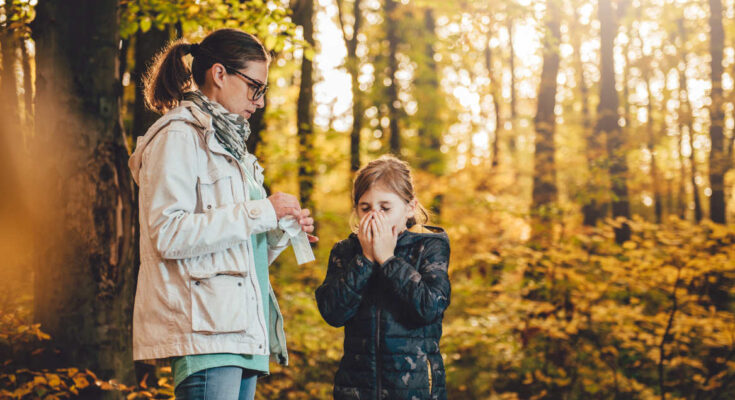Hay Fever Treatment: Hay Fever, medically known as allergic rhinitis, is a common condition affecting millions globally. It triggers cold-like signs and symptoms such as a runny nose, itchy eyes, congestion, sneezing, and sinus pressure.
However, unlike a cold, hay fever isn’t caused by a virus. The condition is induced by an allergic response to outdoor or indoor allergens like pollen, dust mites, or pet dander.
Understanding Hay Fever
Hay fever, medically known as allergic rhinitis, is a common allergic condition that significantly affects a large portion of the population worldwide. This condition is characterized by an overreaction of the immune system to certain outdoor or indoor allergens. Unlike other types of allergies that might affect various parts of the body, hay fever primarily targets the nasal passages, causing symptoms such as sneezing, runny or blocked nose, itchy eyes, and sinus pressure.
Common Allergens That Trigger Hay Fever
The triggers of hay fever vary widely but can be primarily categorized into two groups: seasonal and perennial. Here’s a list of common allergens associated with each:
Seasonal Allergens:
- Pollen from trees (such as birch, cedar, cottonwood, and pine)
- Grass pollen (which is most prevalent during late spring and summer)
- Weed pollen (such as ragweed, nettle, and mugwort, typically found in the fall)
Perennial Allergens:
- Dust mites
- Pet dander (small flakes of skin shed by animals)
- Mold spores (both indoor and outdoor)
Identifying the specific allergen causing hay fever is crucial as it helps tailor the most effective treatment and management strategy.
Statistics on Hay Fever Prevalence
Hay fever is more than just a minor annoyance; it’s a widespread health concern. According to health surveys, hay fever affects about 10-30% of the adult population worldwide and as many as 40% of children. In the United States alone, over 19 million adults were reported to have been diagnosed with hay fever in the past year, and these numbers are mirrored in many other countries, highlighting the global impact of this allergic condition.
However, understanding the scope of hay fever is essential for recognizing its significance as a public health issue. It underscores the need for awareness, effective management strategies, and comprehensive healthcare support for those affected. By familiarizing ourselves with the definition, common triggers, and prevalence of hay fever, individuals and healthcare providers can better navigate the challenges this condition presents.
Symptoms of Hay Fever
Understanding the symptoms of hay fever is crucial for timely and effective management. Below is a detailed list of symptoms commonly associated with this allergic condition:
- Sneezing: Frequent, intense bouts of sneezing are one of the hallmark symptoms of hay fever.
- Runny or Blocked Nose: A runny nose with clear mucus is typical, though nasal congestion is also common.
- Itchy Eyes, Nose, Ears, and Throat: Itching in these areas can be particularly distressing and persistent.
- Watery, Red Eyes: Often referred to as allergic conjunctivitis, this symptom can cause significant discomfort.
- Postnasal Drip: This occurs when excess mucus runs down the back of the throat, leading to coughing or a sore throat.
- Sinus Pressure: Swelling in the sinus passages might cause pain and headaches.
- Fatigue: Many people with hay fever report feeling unusually tired, which can be exacerbated by poor sleep quality due to symptoms.
Impact on Daily Activities and Quality of Life
The symptoms of hay fever can significantly affect daily activities and overall quality of life. Here’s how:
- Reduced Productivity: Symptoms such as sneezing, a runny nose, and itchy eyes can distract and inhibit one’s ability to concentrate, leading to decreased productivity at work or school.
- Impaired Sleep: Nasal congestion and postnasal drip often worsen at night, disrupting sleep and leading to fatigue during the day.
- Social Disruptions: The discomfort and visibility of symptoms like red, watery eyes and constant nose-blowing can make social interactions uncomfortable and embarrassing.
- Outdoor Activities: For many, the outdoor activities are severely limited due to the increase in symptoms caused by exposure to pollen.
- Mood Effects: Chronic discomfort can lead to irritability and stress, further affecting mental health and emotional well-being.
However, early diagnosis and treatment can help alleviate symptoms and improve quality of life, allowing individuals to maintain their daily routines with minimal disruption.
Diagnosing Hay Fever
Proper diagnosis is crucial for effective management. Here’s a closer look at the steps involved, the tests used, and the crucial role of allergists in diagnosing hay fever.
Initial Steps in Diagnosing Hay Fever
Medical History: The first step in diagnosing hay fever involves a detailed discussion of the patient’s medical history. Healthcare providers will ask about the symptoms, their duration, and any seasonal patterns. Understanding family history of allergies can also provide insights, as hay fever often runs in families.
Physical Examination: A physical examination helps doctors rule out other conditions that might mimic hay fever, such as the common cold or sinus infections. The examination typically focuses on the nose, eyes, and throat, looking for signs of allergic reactions such as nasal congestion or swollen nasal passages.
Tests Used to Confirm Hay Fever
To confirm a diagnosis of hay fever and identify specific allergens, several tests may be employed:
- Skin Prick Test: This is the most common test for diagnosing hay fever. Small amounts of suspected allergens are placed on the skin, usually on the forearm or back, and the skin is lightly pricked. A positive reaction, typically a small bump resembling a mosquito bite, indicates an allergy to that substance.
- Intradermal Test: If the skin prick test results are inconclusive, an intradermal test may be performed. This involves injecting a small amount of allergen just beneath the skin surface. It’s more sensitive than the skin prick test and can be used to detect a wider range of allergies.
- Blood Test (Specific IgE Test): This test measures the amount of allergy-causing antibodies in the bloodstream, known as IgE antibodies. A blood sample is sent to a lab to test for reactions to specific allergens.
- Patch Test: Although less common for hay fever, patch tests can be used when a delayed allergic reaction is suspected. Allergens are applied to patches, which are then placed on the skin for 48 hours to check for reactions.
The Role of an Allergist in Hay Fever Diagnosis
Allergists are specialists trained to diagnose, treat, and manage allergies, asthma, and other immune system disorders. An allergist plays a pivotal role in diagnosing hay fever through:
- Expert Evaluation: Allergists can evaluate symptoms comprehensively, distinguish between allergies and other similar conditions, and recommend effective treatment strategies.
- Customized Testing: Based on the initial assessment, allergists can determine the most appropriate tests to identify the specific allergens causing symptoms.
- Management Plans: Post-diagnosis, allergists develop personalized management plans that often include avoidance strategies, medications, and possibly immunotherapy.
Proper diagnosis of hay fever is the first step toward relief. With the right combination of medical history assessment, physical examination, targeted testing, and specialist involvement, individuals suffering from hay fever can achieve substantial improvement in their quality of life.
Treatment Options for Hay Fever
Fortunately, several effective treatment options are available to help manage and alleviate these symptoms. Below, we explore the various strategies, including medications, long-term treatments, and lifestyle modifications.
Medication Options for Hay Fever
Medications are a cornerstone in the management of hay fever. The most commonly used medications include:
- Antihistamines: These drugs work by blocking histamine, a substance in the body that causes allergic symptoms. Available in pill, liquid, or nasal spray forms, antihistamines can help reduce sneezing, runny nose, and itching. Examples include cetirizine, loratadine, and fexofenadine.
- Nasal Corticosteroids: Nasal sprays such as fluticasone, budesonide, and mometasone are often prescribed to reduce inflammation in the nasal passages, helping to relieve congestion, sneezing, and runny nose.
- Decongestants: These medications are used to relieve nasal stuffiness by narrowing blood vessels and reducing swelling in the nasal passage. Decongestants are available as pills, liquids, or nasal sprays, but should not be used for long-term treatment as they can cause a rebound effect if used too frequently.
Long-Term Treatments for Hay Fever
For those seeking a more long-term solution, immunotherapy may be an option. This treatment involves regular injections of allergen extracts, aimed at desensitizing the body’s immune response to these allergens:
- Allergy Shots (Subcutaneous Immunotherapy): Administered over a period of several years, allergy shots are the most traditional form of immunotherapy. They are particularly effective for people with severe allergies and can lead to lasting relief even after treatment ends.
- Sublingual Immunotherapy (SLIT): This newer form of immunotherapy involves placing a tablet containing a small dose of the allergen under the tongue daily. It is a good alternative for those who prefer not to receive injections.
Lifestyle Changes and Home Remedies
In addition to medical treatments, certain lifestyle changes and home remedies can help alleviate the symptoms of hay fever:
- Avoid Allergens: Try to reduce your exposure to the allergens that trigger your symptoms. This might involve staying indoors on high pollen days, using air purifiers, or washing clothes after outdoor activities.
- Nasal Irrigation: Using a saline solution to flush out the nasal passages can help relieve nasal congestion and irritation.
- Maintain Clean Indoor Air: Keeping windows closed during high pollen seasons and using air conditioning in cars and homes can reduce exposure to allergens.
- Herbal Remedies: Some people find relief through herbal remedies such as butterbur or spirulina, though it’s important to consult with a healthcare provider before starting any new treatment.
By combining these treatment options with advice from healthcare professionals, individuals suffering from hay fever can achieve significant relief from their symptoms and improve their quality of life.
Prevention and Management Tips for Hay Fever
Fortunately, there are effective ways to manage and prevent these symptoms by minimizing exposure to allergens. Here are some essential tips to help you enjoy the outdoors and keep your indoor environment allergen-free.
Tips for Avoiding Allergens
Avoiding the allergens that trigger your hay fever symptoms is the first step toward feeling better. Here are some practical strategies:
- Stay Informed About Pollen Levels: Check daily pollen forecasts on weather websites or apps. High pollen days might require staying indoors as much as possible, especially during peak pollen times like early morning or windy days.
- Wear Protective Gear: If you need to be outdoors, wearing sunglasses can help protect your eyes from pollen. A pollen mask can also be beneficial, especially during activities like gardening or walking in a park.
- Change Your Clothes After Being Outside: Pollen can cling to clothing, so changing your clothes after you come indoors can help reduce pollen spread inside your home.
- Shower Before Bed: Pollen can also collect in your hair and on your skin, so taking a shower before going to bed can help remove these allergens and improve your sleep quality.
Modifying the Home Environment
Making simple modifications to your home environment can significantly reduce your exposure to allergens:
- Keep Windows Closed: To prevent pollen from entering your home, keep windows and doors closed during high pollen seasons. Use air conditioning in your home and car to help filter out pollen.
- Use Air Purifiers: Air purifiers with HEPA filters can capture a high percentage of airborne allergens, including pollen, dust, and pet dander. Place air purifiers in key areas, especially bedrooms.
- Maintain Cleanliness: Regularly clean floors, surfaces, and soft furnishings with a damp cloth or mop to reduce dust and pollen accumulation.
- Control Humidity: Keep indoor humidity below 50% to discourage mold growth, another common allergen. Use dehumidifiers if necessary, especially in damp areas like basements.
Importance of Monitoring Pollen Counts
Monitoring pollen counts isn’t just about knowing when to avoid going outside. It also helps you plan your activities to minimize exposure when pollen levels are at their highest. Here are some ways to make monitoring effective:
- Plan Outdoor Activities: On days when the pollen count is lower, plan your outdoor activities. This can include exercising, social events, or any work requiring extended time outside.
- Adjust Daily Routines: When pollen counts are high, try to adjust your schedule to avoid peak pollen times. For instance, exercising indoors instead of going for a morning run can make a significant difference in your exposure to allergens.
- Stay Proactive with Medications: If you have prescription or over-the-counter allergy medications, use them according to your doctor’s instructions, especially before days with high pollen forecasts.
By incorporating these prevention and management tips into your daily routine, you can reduce your hay fever symptoms and enjoy a more comfortable, allergy-friendly environment at home and outdoors.
Emerging Treatments and Research for Hay Fever
The field of allergy treatment is continuously evolving, and hay fever, also known as allergic rhinitis, is no exception. Recent years have seen significant advancements in both the understanding and treatment of this common condition, which affects millions worldwide. This section delves into the latest emerging treatments and the promising research that could redefine future management strategies for hay fever.
Innovative Treatments on the Horizon
One of the most exciting areas in hay fever treatment involves targeted therapies that address specific pathways in the allergic response. Biologic medications, which are already transforming conditions like asthma and eczema, are now being tested for hay fever. These biologics work by targeting and neutralizing specific immune system molecules involved in the allergic process. For instance, drugs that inhibit the action of Immunoglobulin E (IgE) – a key player in allergic reactions – are showing promise in clinical trials.
Another promising area is the development of more effective and patient-friendly allergen immunotherapy (AIT). Traditional AIT, which involves exposing patients to increasing amounts of allergens to build tolerance, is being refined to improve efficacy and reduce treatment times. New formulations that can be administered through drops or tablets, rather than injections, are making this treatment more accessible and less invasive.
Ongoing Research and Future Directions
Research into hay fever is not just limited to developing new treatments; it also involves understanding the environmental and genetic factors that contribute to the condition. Scientists are using advanced genetic mapping techniques to identify genes that increase susceptibility to hay fever. This could lead to personalized treatment plans tailored to an individual’s genetic makeup, enhancing the effectiveness and reducing potential side effects.
Environmental research is also pivotal, especially in the context of global climate change. Studies have shown that rising temperatures and CO2 levels can increase pollen production, potentially extending the hay fever season and increasing symptom severity. Ongoing research is focused on strategies to mitigate these environmental impacts on hay fever.
What the Future Holds
The future of hay fever treatment looks promising, with a shift towards more personalized and precise therapies. As researchers gain a deeper understanding of the mechanisms underlying allergic reactions, new treatments are expected to become more effective and less burdensome for patients. Moreover, the integration of digital health tools, such as apps and wearables that monitor environmental allergens, is likely to play a crucial role in managing hay fever more proactively.
However, the landscape of hay fever treatment is set to change dramatically, thanks to ongoing research and emerging treatments. Continued investment in this field is essential to bring these new therapies from the laboratory to the clinic, offering hope to millions of hay fever sufferers around the world.
FAQs about Hay Fever Treatment
What is the best treatment for hay fever?
The most effective treatment for hay fever involves a combination of avoiding allergens and using medications. Over-the-counter antihistamines, nasal corticosteroids, and decongestants are commonly used. For severe cases, allergy shots (immunotherapy) may be recommended.
Can hay fever be cured permanently?
While there is no permanent cure for hay fever, symptoms can be effectively managed with the right treatment approach. Immunotherapy may provide long-term relief for some individuals by gradually decreasing their sensitivity to allergens.
How quickly do hay fever treatments work?
The effectiveness and speed of hay fever treatments can vary. Antihistamines typically begin to relieve symptoms within an hour of intake, while nasal corticosteroids may take several days to become fully effective.
Are there any natural remedies for hay fever?
Yes, some natural remedies may help alleviate hay fever symptoms. These include using saline nasal rinses, consuming local honey to potentially reduce sensitivity to pollen, and maintaining clean air environments in living spaces.
Can changing my diet help with hay fever?
Diet changes alone are unlikely to cure hay fever, but they can support overall immune function. Foods rich in omega-3 fatty acids, vitamin C, and quercetin can be beneficial. Avoiding dairy products may also help reduce mucus production.
When should I see a doctor for hay fever?
It’s advisable to consult a healthcare provider if hay fever symptoms persist despite over-the-counter treatments, or if they significantly interfere with your daily life. A doctor can provide a more personalized treatment plan and check for any possible complications.
Conclusion
In summary, we’ve explored the essential aspects of diagnosing and treating hay fever, a common allergic condition that affects millions worldwide. Understanding the typical symptoms, such as sneezing, itchy eyes, and a runny nose, is crucial for accurate identification. We also discussed various treatment options ranging from over-the-counter antihistamines to more targeted therapies like immunotherapy, emphasizing the importance of a tailored approach based on individual needs.
If you suspect you might be suffering from hay fever, it’s essential to consult with a healthcare professional. They can provide a proper diagnosis and recommend the most effective treatment plan for your specific situation. Remember, managing hay fever effectively not only improves your daily life but also helps prevent more severe allergic reactions in the future. Don’t hesitate to seek professional advice and take proactive steps towards a clearer, more comfortable day-to-day experience.
References
For those seeking further information on hay fever treatments and to validate the details discussed in this article, we recommend the following reputable sources. These references offer comprehensive insights and are widely recognized in the medical community for their credibility.
- American Academy of Allergy, Asthma & Immunology (AAAAI) – This site provides extensive resources on allergies, including hay fever, and offers treatment strategies and research updates. Visit AAAAI
- Centers for Disease Control and Prevention (CDC) – The CDC offers guidelines and educational materials on hay fever and its management, which are beneficial for both patients and healthcare providers. Explore CDC Resources
- Mayo Clinic – A trusted resource for health information, the Mayo Clinic’s website contains detailed articles on the symptoms, causes, and treatments of hay fever. Read More at Mayo Clinic
- WebMD – Known for providing accessible health-related information, WebMD offers easy-to-understand content on hay fever treatment options and prevention tips. Learn More on WebMD
- National Health Service (NHS) – The NHS website includes practical advice and treatment information for hay fever sufferers in the UK, including the latest treatment options and how to use them effectively. Visit NHS
Each of these sources has been chosen for their authority and reliability in the field of allergy research and treatment. They provide a solid foundation for anyone looking to understand more about managing hay fever effectively.



